After my recent Spheres and Circles dinner adventure I decide to put together a quick post on how to get started with frozen reverse spherification.
Process
The basic recipe for reverse spherification is really quite simple. First create your flavourful liquid that you want to spherify and add 2% calcium lactate to the mix. Next freeze the liquid in a mould to create frozen spheres. While the spheres are freezing, prepare a 0.5% solution of sodium alginate dissolved in distilled water (5g sodium alginate in 1000g of water). Let the alginate sit for at least 2 hours to fully hydrate and also lose any bubbles that were created while mixing. I prefer leaving mine overnight in the fridge which matches well with the time it takes to freeze.
The spheres are created by dropping the frozen ice into a warm alginate bath for a ~20 seconds during which the calcium ions in the frozen liquid interact with the alginate bath to create gel skin that encapsulates the spheres. Gently stir the bath without touching the sphere for best results.
Finish up by fishing the sphere out of the alginate bath using a slotted spoon and then stir it in two separate rinsing baths of water to remove any traces of the alginate and place it a holding bath of either oil or the flavourful liquid till you are ready to serve.
Ingredients and equipment
While I started out with a kit from Molecule-R, I feel that if you primarily want to do spherification you are better off buying the following ingredients in bulk. The biggest issue in the kit is that the chemicals come in a limited number of specific sachet sizes which makes it hard to scale your own recipes correctly. Most of the following links are to Modernist Pantry but this should all be available on Amazon as well. The following is what I would recommend as a starter set:
- Calcium Lactate is the source of the calcium ions that you must add to your flavourful liquid. You can also use Calcium Lactate Gluconate which is supposed to be even more flavour neutral but at this point I havent run into any taste issues with straight calcium lactate.
- Sodium Alginate is a seaweed extract that serves as a cold gelling agent and creates the sphere boundary layer.
- Distilled water is the safest way to hydrate the alginate as tap water may contain calcium ions that will cause the alginate to gel prematurely.
- Slotted Spoons are necessary to move you spheres around without contaminating the various baths. They are useful both for making caviar and for the larger spheres I am talking about here. This one is perfectly functional but personally I would get the much sexier Ferran Adria version.
- Digital scales are probably the most important tools you need to do the spherification. You will generally need one to measure larger quantities for the base liquids and another one with 0.1g precision to measure the chemicals. I have been using the linked ones at home with good results.
- An Ice mould/tray is needed to freeze the liquid before you can make the spheres. You do not need the fancy molecular moulds that are sold at the modernist websites. While the fancy ones are definitely easier to remove ice from, I have been using a standard circular ice tray with great results. You should make sure that it is the right size for the sphere you want. The kit mold I got is ~5-7ml in volume while the standard cube is ~10ml in size which makes for a more substantial sphere which I definitely prefer.
- Xantham gum (optional) is a thickening agent for when you want to play with the texture of the fluid in the sphere. I would recommend getting comfortable with basic spherification first before using xantham and other gums to adjust mouthfeel.
- Amuse Bouche spoons (optional) are the most common way of serving spheres. That said you can also serve them in regular soup spoons, shot glasses, etc…
Tips and Tricks
I have now done this several times and have created spheres of a wide range of things from mojitos and bloody marys all the way to yogurt and mango puree. The following are some tips and tricks that may help you get you spheres done better/faster
- Mix the lactate using an immersion blender – leads to a very fast and even mix. It does however create a lot of bubble and you want to let the liquid rest in the fridge for a while to lose the bubles before pouring in the mould. You can mix with a spoon as well but I find that the last bits of the lactate dont always dissolve and I sometimes have to strain the mix to remove them.
- Watch the texture of the liquid before you freeze it. Liquids with a thicker consistency (mango puree, yogurt, bloody mary mix) have a better mouthfeel when they burst. That said there are certain liquids that work better are regular fluids due to the original expectations (eg: pani for pani puri). You can use xantham gum (say ~0.5%) to slightly thicken the liquid but be careful with bubbles as the thickened liquid will not lose them easily.
- For encapsulating spheres (eg: spherified mojito with an encapsulated min leaf below) take care that the encapsulated item is entirely enclosed in the ice. If any part of it sticks out of the ice it will cause the alginate skin to rupture. I recommend using 2 step freezing where you first fill the mould half way and drop the floating substance in the mould and wait for it to freeze completely before adding a second layer of liquid on top to guarantee encapsulation. In the case of a heavy substance that sinks you will want to add the item while making the second layer.
- You do not have to store frozen spheres in the mould. When I am making several different kinds of spheres I freeze each liquid overnight, pop it out of the mould and store them in a closed container in the freezer. This is particularly useful when you have limited moulds and lots of spheres to make.
- Do the spherification well before the meal. Sometimes you run into issues during spherification or may have yield issues so I suggest doing the alginate bath step several hours before the meal itself. Doing it just before guests arrive adds more pressure to the meal than I would like.
- Use a warm alginate bath for fast spherification. If you warm the bath to ~50C it helps the sphere to melt faster and form the skin quicker.
- I find that using a saucepan with non vertical edges makes it easier to pull the spheres out with the slotted spoon. I get more breakage when I use a saucepan with vertical walls.
- Experiment with how long you want the keep the sphere in the alginate bath. The longer it stays the thicker the skin will be. You generally want as thin a skin as possible especially for non-viscous liquids. Having the bath set to a specific temperature will help you improve the repeatability of the spherification. I generally use 20 sec per sphere in a 60C bath.
- Leave the frozen spheres in the freezer for as long as possible. I prefer pulling them out 2-3 at a time so that they are still solid when I drop them in the bath. If they start melting before the bath they end up leaking liquid into the bath which can break the spheres.
- Wipe your spoon with a dry paper towel every time you dip it in the alginate bath. This prevents any contamination from the holding bath. Wipe the bottom of the slotted spoon with a paper towel to absorb excess water before adding the holding bath – this is particularly important if you are using oil to hold the spheres.
- Wait at least 10 min after the spherification bath to let the core of the sphere melt before serving.
- Keep checking the alginate bath for any gel floating in the mixture. This is particularly important if you have been having yield issues as the ruptures spheres leave a lot of gel reside that affect future spheres being made. Luckily the slotted spoon is usually sufficient to fix the gel out
- If you are making a large number of spheres (say 20+) you probably want to make excess alginate and use it in batches rather than topping up the same bath. This will help reduce any issues from free floating gel in the bath. Plus if you have excess alginate you can always store it in the fridge for later use.
- You can store the completed spheres in a bath of olive oil for several days but then you end up having to thrown the oil away as you cant really reuse it. Instead I prefer storing the spheres in a batch of the flavourful liquid itself as you can always drink the liquid after service.
- While amuse bouche spoons are the most common serving methond for spheres, you should feel free to play around with different things. I have served them in shot glasses (with and without other liquids), on a wafer, suspended in alcohol, directly in the holding bath, etc… Sperification is all about experimentation and that should extend to the plating as well
- Consider using lab beakers to measure and mix the ingredients. They are cheap, oven safe, microwaveable, easy to clean and allow you to inspect the bottom to check if the chemicals have dissolved completely. They are also super easy to pour from – I usually use a 100ml beaker to fill the moulds as it gives me good control and allows me to measure the amount poured.
- Play with the serving temperature of the spheres by adjusting the holding bath temperature. For higher temperatures you can heat the bath before adding the spheres while for lower temps just refrigerate the spheres in the bath. If you do heat the spheres please warn the guest before they eat them as you dont want anyone to burn their mouth with something that is too hot.
- Try serving your spheres with other interesting accompaniments. Common ways to punch up the flavour and texture are to drizzle olive oil, shave cheese over the top, plate on a crunchy bed, top with sauces, sprinkle salt/spices, etc… For example the pani puri spheres below have been topped with a sweet tamarind sauce and served with a fried chickpea balls to replicate the crunch of a puri breaking.
Wrap-up
Hope you folks liked my guide to frozen reverse spherification. As you can see it is a very simple technique that can easily be done at home. It does takes some time but most of that is in prep work to be done before the meal. You can also pre-make the spheres a day or two before the meal and store them in the holding bath till you are ready to serve.
The following are some of the spheres I have made with this exact same process and should be straightforward to repeat:
- beet juice
- mango puree
- bloody mary (alcohol)
- bloody may mix (no alcohol)
- orange juice
- grapefruit juice
- mojito (alcohol)
- pani (spicy liquid for pani puri)
- yogurt
Thanks for reading and go try out some interesting spheres of your own.
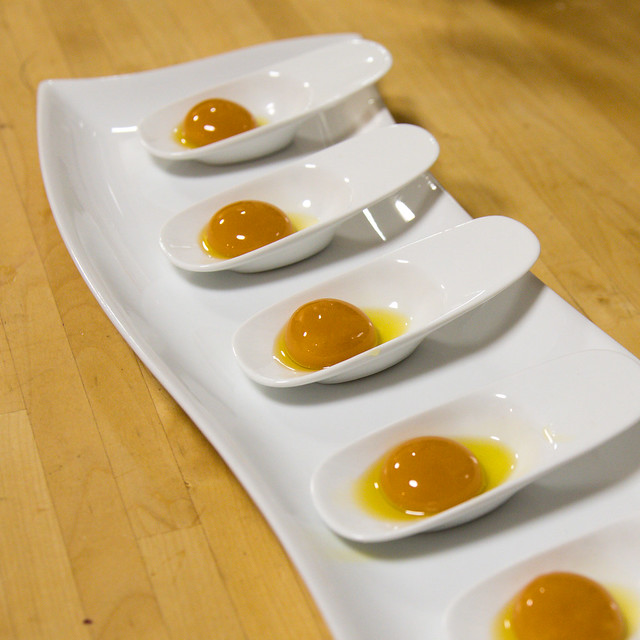
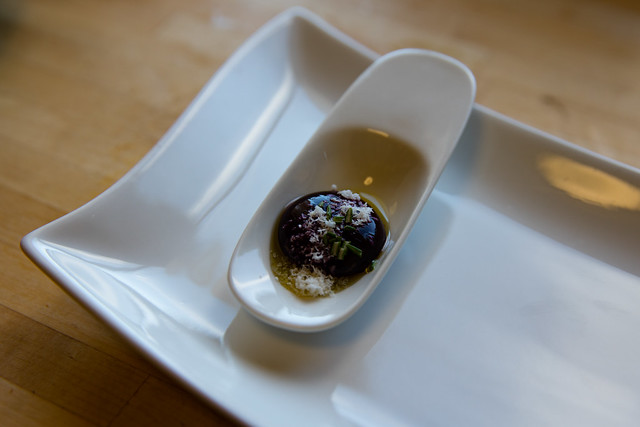
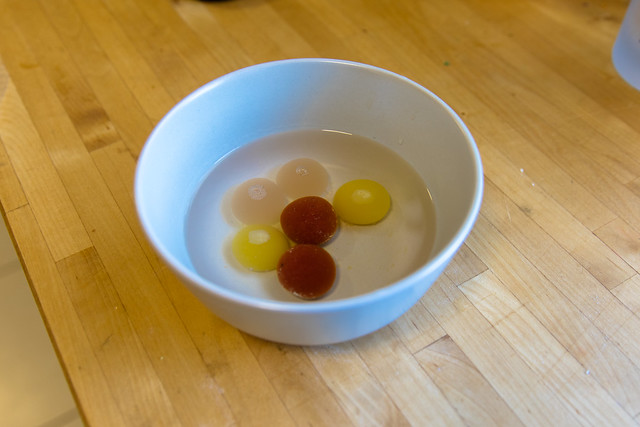

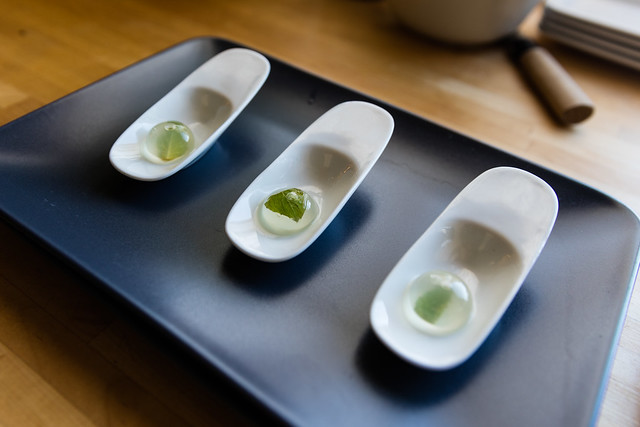
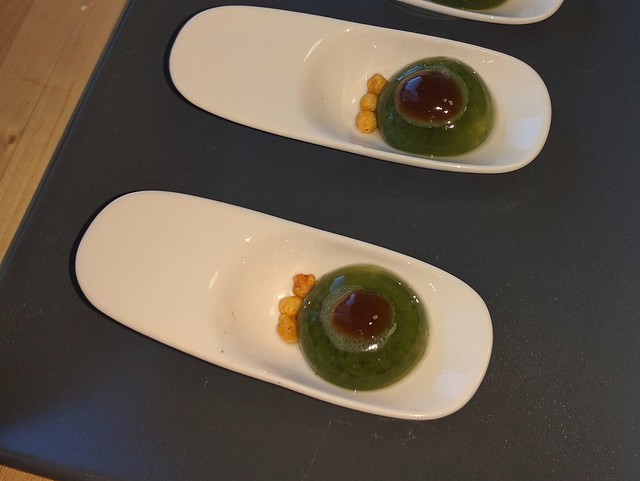
28 replies on “A guide to Frozen Reverse Spherification”
[…] many different spheres taught me a lot about spherification which I will be writing up as a future tips and tricks blog post. Overall it is very fun technique and something more people should try out as it gives really […]
Hi, I loved your guide. I tried reverse spherification tonight. Everything went well until I had to submerge my frozen spears into the warm sodium aginate bath. They instantly melted but never formed a gel a cap on the outside. Any advice? Perhaps I didn’t put enough calcium m lactate into my juice mixture before I froze them?
As long as you were at 2% lactate and 0.5% alginate it should have worked. Couple of thing to watch out for are
Try those out and do let me know if that helps.
[…] This is an older dish I have made before and it is basically mango puree with a little smoked paprika that has been made into a “yolk” using frozen reverse spherification. […]
Thank you so much Rahulnair. I finally got up the nerve to try again and it worked perfectly.
hi Rahulnair
I tried a you guided. I am trying to make milk tea spheres (milk + tea + sugar as flavored liquid+0.3% xanthan gum ). I see the spheres formed but once I get it out of the bath, it flattens and gets bursted (I tried to leave the spheres in the bath for 10 minutes to thicken the outside membrane). I am wondering if the sugar and milk in my flavored liquid is a problem. If it is, are there any way to fix this. Thanks alot
@Nguyễn – try reducing the sugar content and try again. High sugar or acid content can affect sphere formation. Acid can be counteracted with sodium citrate but there isnt much you can do about sugar.
Why does my sphere leak in the alginate bath? My alginate bath is cold
Also why is there like a tail of jelly joined with the sphere when dropped in the alginate bath
@Angel – it sounds like your sphere might have started melting before you dropped it in the bath. If there is any melted liquid on the outside of the sphere before it goes in the bath it will create those tails and remnants in the bath. I leave the frozen spheres in my freezer and pull them out one at a time and immediately drop them into the bath.
Also you want the bath to be warm instead of cold – the greater the difference between them the faster the frozen sphere will melt and release calcium ions that cause the skin creation. As I mention in the post I like keeping my alginate bath at ~120F which usually gives me a sphere in about 20 seconds.
Thankyou for the qiuck response ans tip. Also do i have to let my alginate bath sit in the fridge for 12 -24hrs to remove bubbles and then warm the bath before dropping in the spheres?
I can see the bubbles of my liquid mixture in the spheres when i drop it in the alginate bath . Is it normal? How do i remove it? Thankyou
i can see the air bubbles of my liquid mixture in the spheres when it has defrosted in the alginate bath. is it normal to see air bubbles through the sphere? how do i remove it ?
@Angel – letting the bath sit overnight in the fridge is the best way to remove the bubbles from the alginate. Also while warming it try to do it on very gentle heat so that you dont create bubbles on the sides and bottom of the warming saucepan.
@sarah – the bubbles in the sphere are generally due to air being trapped in the flavorful liquid at the time of freezing and is especially likely if you used blender to mix the calcium salts. I recommend letting the liquid sit overnight in the fridge to let the bubbles all disappear before freezing. In some liquids you may have to gently stir it periodically to get rid of all the bubbles. Another trick is to quickly run a blowtorch flame over the surface of the liquid to pop bubbles but you need to be careful not to cook the liquid and potentially change the flavour.
Additionally letting the liquid cool in the fridge overnight leads to faster freezing which also reduces the occurrence of bubbles.
Can we make vinegratte dressing by using reverse frozen spherification
Hey Rahul, no clue if you still check this regularly. Wanted to try making the pani puri variant of this dish. I had a few questions regarding the acidity of my pani. We normally make it very strong on the acid and minty side of things. Should I still be utilizing reverse sodium alginate? Or is this where you’d recommend utilizing sodium citrate? What proportions do you typically use for this.
@Jai – Mint should not be a problem and I’m not sure if I’ve ever had pani that is acidic enough to cause issues. I typically use just store bought pani mix and reduce the dilution to make it extra spicy. That version works out of the box with the usual 2% of Calcium Lactate or Calcium Lactate Gluconate. I would try the base version first before using sodium citrate. If you do use sodium citrate you will need to experiment to find the right ratio that raises the pani pH above ~3.6.
@Thak. Vinaigrette is typically quite acidic which will be a problem for spherification. If the pH is less that ~3.6 you will have to add sodium citrate or some other base ingredient to reduce the acidity of your flavourful liquid.
does green panipuri water need thickening?
I didn’t use any thickening agent as I wanted to feel as watery as possible
I am trying to sphere concentrated coffee. It keeps melting in the bath. I’m assuming it’s because of the ph level. Can you recommend what percent of sodium citrate I should add? Thanks!
@Dan. You will likely have to test this out as it will depend on the acidity of the coffee and the purity of the sodium citrate. I would separate a pot of coffee into a 4-5 batches and add different amounts of citrate to see. I’d love to hear what you end up with as working.
Hello Rahul. I’ve just sent you a request on Linked In. I was wondering how long I could store these if I use an oil solution or flavored liquid solution.
Thank you!
Taylure Ruggeri
I personally have kept them for a max of two days but that is more due to my available prep time and not any absolute limit. I find that keeping them in the flavourful liquid keeps them in better shape than oil where they do seem to deflate a little and lose a bit of shape within 24 hours or so.
I’m using your instructions to make mint julep spheres. They have been in the freezer for ~5 hours and don’t seem to be hardening well. They are pretty slushy. Any idea how to fix this before I move forward with the next step?
I started the process and I’m using this to make mint julip spheres for this weekend. The liquid has been in the freezer for about five hours now and it seems more slushy than it should be. Any idea on how to fix this before I move forward?
@Sarah – Generally the higher the sugar content the lower the freezing point will be. You could diluting the sugar a bit and see if that helps but it will affect the tasts